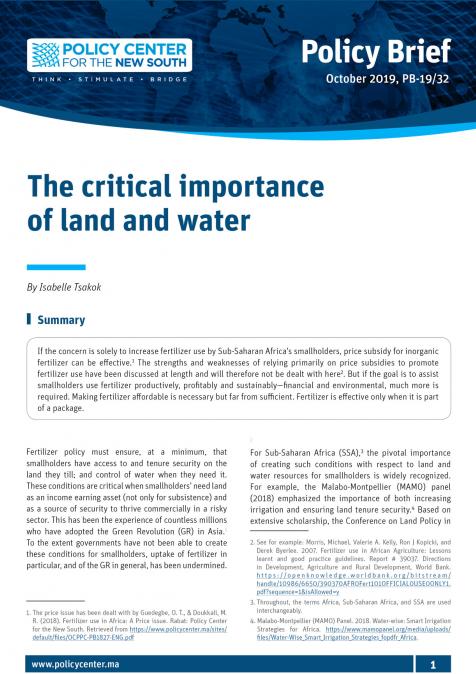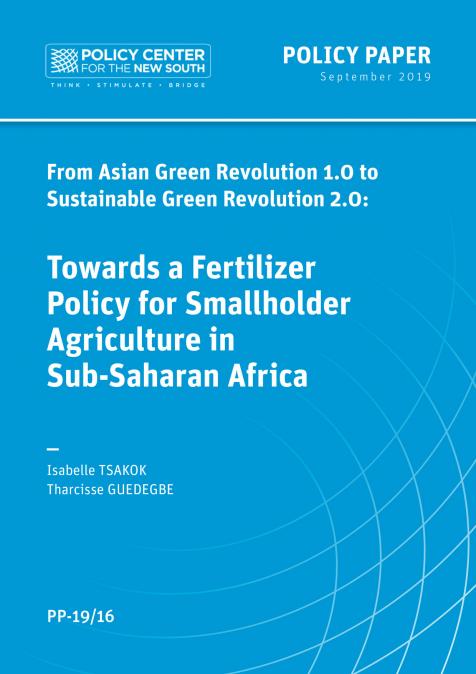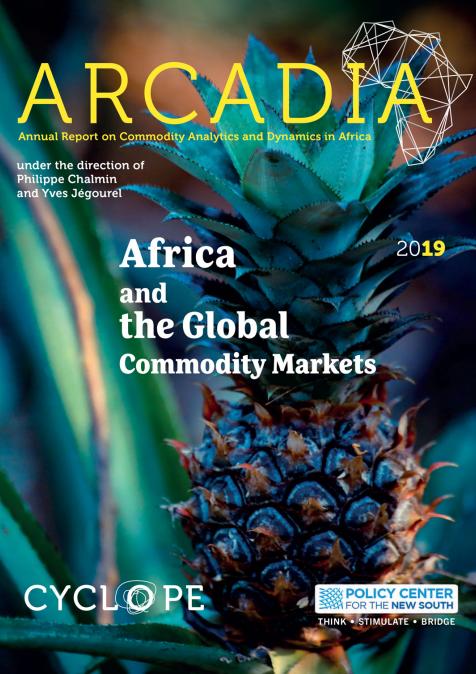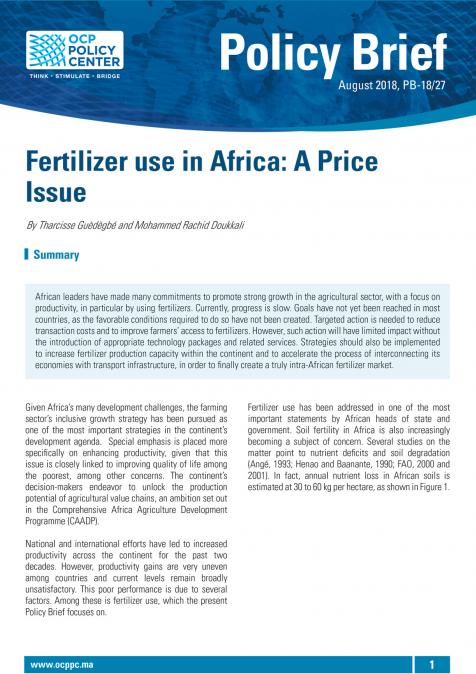Publications /
Opinion
The Food and Agriculture Organization (FAO) consecrated the year 2015 as the International Year of Soils (IYS). Therefore, it has been a year intended to raise the consciousness of humanity about the importance of this resource (soil) and the need to preserve it to ensure sustainable and shared prosperity. The various stakeholders in the management and use of this resource, particularly those of the agricultural sector have been called to enhance their consideration of this fragile and threatened resource, to reverse the degradation trend by placing its management and use in a sustainable approach. The international community has reaffirmed its commitment to protect this resource through targets 2.4 and 15.3 of the sustainable development objectives adopted in 2015.
This internationally bell sound have given some results. The conference on "Afro-Mediterranean soils: constraints and potential for sustainable management" was born in Morocco, and held its first edition from December 18 to 19, 2015 in Marrakech. It was an exceptional meeting between various stakeholders committed to the knowledge, management and sustainable use of soils in the Afro-Mediterranean area. This helped to share the experiences of each other, discuss recent progress in six key areas and promote intra-regional cooperation. The six areas are: carbon management and sequestration and climate smart agriculture; soil erosion and conservation measures; information and modeling of soil; soil quality and monitoring of land degradation; managing soil fertility and crop fertilization; the link between research and extension for an eco-efficient land management.
What are the issues?
Understanding why soils focus such attention is not complicated. In the twelfth century, the andalusian agronomist Ibn-Al-Awan wrote in his Book on agriculture, "The first step in the science of agriculture is the recognition of soils and how to distinguish which is of good quality and which is of inferior quality. He who does not possess this knowledge lacks the first principles and deserves to be regarded as ignorant". In its evolution, science has allowed to become more and more aware of the multiplicity of roles that soils play for humanity and the threats they face.
In agriculture, soils are a key factor of production. They are the rooting carrier for food and industrial crops and pasture plants. About 95 percent of our food is produced directly or indirectly through the soil. Its availability and good health are so critical for our food security, and that of future generations. In addition, the soils are involved in maintaining ecosystems and natural processes that support human life through many ecosystem services. Indeed, not only soils maintain the biodiversity of which they are home to a quarter of the total, but they contribute to mitigation and adaptation to climate change through carbon sequestration. They also contribute to the storage and filtration of water, useful for the nutrition of plants and human food. To ensure all these functions, soil must be healthy (good structure, good organic content, good moisture level, good biological activity, etc.). Today, this useful and scarce resource is subject to degradation.
Currently, the soils are highly degraded. This is mainly due to unsustainable agricultural practices (bad use of synthetic inputs, deep plowing, overgrazing, conversion of grassland and forest to cropland and pastureland, etc.). About 33 percent of soils are moderately or severely degraded by erosion, nutrient depletion, acidification, salinization, compaction and chemical pollution. On lands prone to degradation, agricultural productivity decreases as well as carbon sequestration capacity.
It follows a growing loss of fertile soils that amplifies the scarcity of this resource, which, in this context of high population growth, highlights the challenge of feeding a growing population. It can also generate and intensify land conflicts and amplify migrations. Similarly, poor agricultural practices result in the release of carbon dioxide into the atmosphere, a greenhouse gas. Given the importance of agriculture to micro and macro levels in developing countries – that make most of this Afro-Mediterranean region – these consequences are unacceptable.
However, even if the soil is a nonrenewable resource, restoration, preservation and improvement of its fertility are possible. Stakeholders in its management and its use should work to reverse the current deteriorating trend. In agriculture, it is necessary to operate in a new more sustainable exploitation of the soils. To do this, and as we have seen in the first conference on the potential and constraints of Afro-Mediterranean soils, some initiatives have been taken, the research is active in this area and there are some solutions.
How to reverse the trend?
As part of the new climate-smart agriculture logic, new sustainable agricultural development policies must then incorporate extension of agricultural approaches that manage and sustainably use land. Numerous approaches exist and are already well experienced in some areas. In developing countries, those to extent massively must also allow the farmer to have gains in yields and in profitability. At the national level, they should at least allow an agricultural growth and accessible food production to consumers. It is also important that the techniques related to the implementation of these approaches are accessible to farmers. The best-known approaches are agro ecology, organic agriculture, conservation agriculture and agroforestry.
Among these approaches, agriculture conservation seems most advocated in this Afro-Mediterranean region. It is already present in many countries and based on three principles: elimination of tillage, permanent soil cover and crop rotations. The integration of these three principles should allow production meet the economic objectives while keeping and improving the soil quality and thus increasing its carbon sequestration capacity. Methods of land cover (organic materials, minerals or plastic), and families of plants (grasses, legumes, etc.) whose rotation improves soil fertility and productivity, can be found in all countries. Some of them are already tested and prove productivity gains and improvements in soils quality. Therefore, it is important for agricultural policies to better promote these methods and increase their support for research to improve the effectiveness of these methods (through moisture management especially in the context of rainfed agriculture, management of organic matter, etc.).
The accessibility of this practice for farmers in developing countries can become difficult in case of using machines, especially no-till seeders. Nonetheless, conservation agriculture would gain much from mechanization, because this would significantly improve its productivity. Assuming an existence of such machines and their adaptation to local environments – that is not the case in many countries –, it would be necessary to design for small farmers some community systems for acquisition, use and management of these machines. These systems would benefit from relying on local social organizations and should prove a better profitability for farmers. Accessibility is thus an important element to consider in the design of these new agricultural policies.
Related to research, extension must diffuse good agricultural practices of soil management. For better efficiency, extension institutions need to be much better supported (better-trained agents, more numerous and availability of financial resources). Observation systems should be set up to track the degradation. They will allow an assessment of the effectiveness of the extension through the effect of practices implemented by farmers on soil quality. These systems should allow for more careful monitoring and a more rapid and appropriate response.
A modern extension
Another aspect of extension is its increasing modernization. Map of soils fertility under development in Morocco is a striking example. It is an online software solution developed within the framework of an agreement between the Ministry of Agriculture and Fisheries and the OCP Group. It helps diffuse the information on soil fertility of cropped lands in Morocco and present recommendations on fertilization for sustainable production. A similar system is also under development in Ethiopia. If well made, these systems should allow for a celerity of agricultural advice. However, still not widespread in this region, these systems still have difficulties that we should quickly overcome for a full operationalization.
We could achieve this through more increased support for research and closer cooperation between different actors working for their realization in different countries. These cooperative efforts will enable faster technology transfer and provision of the necessary expertise for the implementation of such tools. The future extension lies in the use of new technologies of information and communications, and harmonization of the underlying techniques. Currently, most African countries are far behind in the computerization of their knowledge on soils, first step in the implementation of modern extension systems. Also, do not forget that even though these systems were operational, their employability by the farmers still depends on access of these latter to electricity, their mastery of computers and the access to telecom network or internet. However, the traditional extension has to be substantially improved.
Furthermore, if the management of cultural practices seems to focus all attention, we must not lose sight of the problem of overgrazing, which also plays a role in land degradation. We must also consider the approaches available to a practice of extensive livestock farming allowing sustainability of pastureland. From this side too, we should develop an arsenal of new systems for monitoring and extension.
From COP-21 to COP-22
COP-21, held in Paris was an opportunity for countries to renew their commitment to mitigate and adapt to climate change. The initiative called "4 per mille" adopted there is an international research program that aims to increase by 4 per 1000 per year (or 0.4 percent per year) organic matter stocks. This growth rate should be sufficient to offset all emissions of greenhouse gases. Developing countries have much to gain in the realization of this initiative. Indeed, the efforts deployed in this direction will help to improve soil fertility and thus to achieve the food security objectives and other objectives.
The realization of such an initiative requires genuine participation of all stakeholders in all countries. At the local, national and regional levels, objectives, concrete actions and deadlines should be set as soon as possible so that the combination of these efforts can contribute to achieving this very profitable international commitment. It has been estimated that developing countries have to increase their agricultural production by almost 100 percent to only meet their food demand by 2050. Examples of good practices should be promptly identified, examined scientifically in all aspects (economic, social and environmental), and must be diffused.
The COP22 will take place in 2016 in Morocco. It should be an opportunity for Afro-Mediterranean countries, and more generally developing countries, to require from the international community the establishment of financial, technical and institutional mechanisms that allow accelerating research and the establishment of approaches for sustainable land management and monitoring degradation both in terms of cultivation practices and husbandry practices. This will require placing soil management among the main issues on which decisions must be absolutely taken. A reflection on the design of this set of devices should start now at the local, national and regional levels between all stakeholders.








